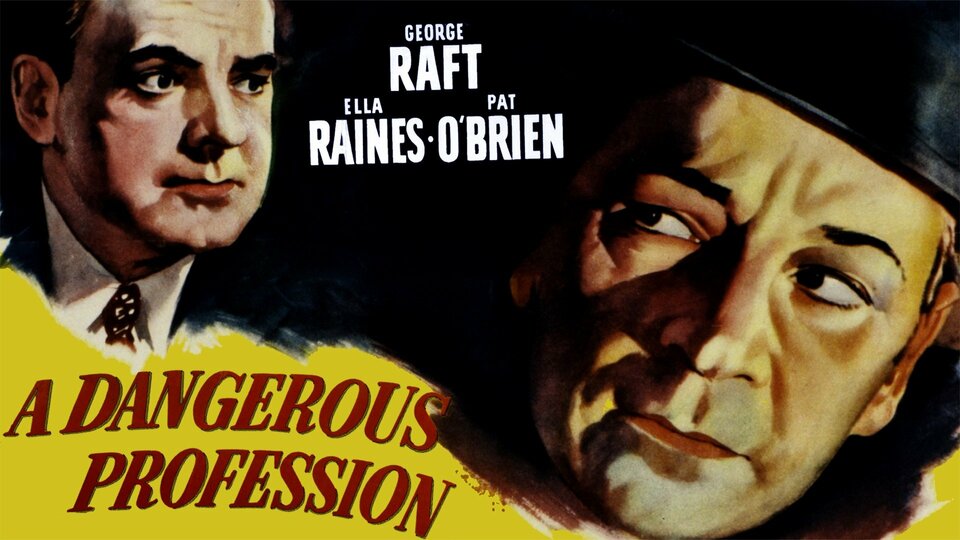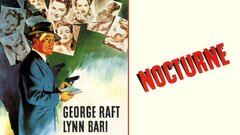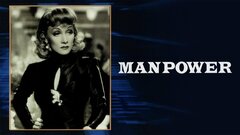A former Broadway dancer, actor George Raft achieved stardom playing tough guys throughout the 1930s and 1940s. After gaining attention on Broadway for his unbelievably fast Charleston, Raft moved to Hollywood, where he had numerous supporting parts before landing his breakout role in Howard Hawks' infamous crime drama, "Scarface" (1932). An overnight success, he went on to appear in "The Bowery" (1933), "Bolero" (1934), "The Glass Key" (1935), "Each Dawn I Die" (1939) and the excellent melodrama "They Drive by Night" (1940).
But just as he was on the cusp of true stardom, Raft famously turned down the leads in "High Sierra" (1941) and "The Maltese Falcon" (1941), both of which went to Humphrey Bogart, turning him into a major star. Raft continued to star in a number of films throughout the decade like "Background to Danger" (1943), "Johnny Angel" (1945) and "Outpost to Morocco" (1949). He later spoofed his tough guy image in "Some Like It Hot" (1959). Raft remained one of the Golden Age's more prominent performers.
Born on Sept. 26, 1895 in New York, NY, Raft was raised in the rough-and-tumble neighborhood of Hell's Kitchen by his German immigrant parents, Eva and Conrad Raft. Growing up in a rough part of town, Raft was naturally close to criminal elements and was the boyhood friend of Owney Madden, who later ran the famed Cotton Club in Harlem.
In the early 1920s, Raft showed an aptitude for dance and began working in a number of nightclubs, leading to a deepening association with various gangsters. He eventually worked with Madden as a gun thug and wheelman on bootleg runs, but continued to dance and dream of becoming a big star.
In 1929, with Madden's encouragement, Raft basically played himself in the crime drama, "Queen of the Nightclubs" (1929), which focused on a fictionalized account of a speakeasy owner (Texas Guinan) dealing with the murder of a close friend (John Davidson).
Raft was given a small role where he showed off his moves in a fast-paced Charleston dance solo, which had first brought him fame on the Broadway stage back in New York.
In the early part of his film career, Raft had small parts in films like "Quick Millions" (1931) starring Spencer Tracy, "Palmy Days" (1931) with Eddie Cantor, and "Winner Take All" (1932) starring James Cagney.
After being punched out by Cagney during a dance competition in Roy Del Ruth's "Taxi!" (1932), Raft was propelled to stardom as the coin-flipping killer who serves as a henchman to psychotic gang boss Tony Camonte (Paul Muni) in Howard Hawks' violent gangland classic, "Scarface" (1932).
So convincing was his performance that audiences thought Raft was a real-life mobster, which in reality was not too far removed from the truth. In fact, Raft remained connected to the East Coast mob and often carried out favors for them, including breaking off a relationship between a gangster's moll and famed lothario Gary Cooper.
Meanwhile, Raft ran into his own trouble with women after having married Grayce Mulrooney, a woman several years his senior, in 1927. Though they separated soon after, Mulrooney refused to grant him a divorce due to her devout adherence to Catholicism and the two stayed married until her death in 1970.
Still, Raft maintained a number of romances with the likes of Betty Grable, Lila Chevret, Marlene Dietrich and Mae West.
Meanwhile, Raft played variations of tough guys throughout the 1930s in "Night After Night" (1932) opposite Mae West, William Wellman's "Love is a Racket" (1932) and the multi-director anthology "If I Had a Million" (1932), where he played a Death Row inmate who is one of the lucky recipients of an inheritance from a wealthy businessman (Richard Bennett).
From there, he was second billed as Steve Brodie, the first man to ever jump off the Brooklyn Bridge and live - or so he claimed - in Raoul Walsh's historical drama "The Bowery" (1933).
He followed with turns as an undercover agent who infiltrates a gang of jewel thieves in "Midnight Club" (1933), a Mexican matador in "The Trumpet Blows" (1934) and a nightclub dancer who falls for his partner (Carole Lombard) in the musical drama "Bolero" (1934).
After starring opposite Anna May Wong in "Limehouse Blues" (1934), Raft was the former strongman for a crooked politician who tries to solve a strange murder while being pulled into a deadly game of corruption in "The Glass Key" (1935), which was adapted from a story by Dashiell Hammett.
Raft continued his rise to stardom with supporting roles in Henry Hathaway's "Souls at Sea" (1937) and Fritz Lang's underrated film noir "You and Me" (1938), as well as leading roles in "Spawn of the North" (1938), an adventure on the high seas co-starring Henry Fonda and Dorothy Lamour.
After "The Lady's from Kentucky" (1939) and "I Stole a Million" (1939), Raft reached the height of his career with a supporting turn opposite James Cagney as a hardened con in "Each Dawn I Die" (1939).
He next starred in the excellent melodrama "They Drive by Night" (1940), playing the owner of a trucking firm battling all manner of crooks and unscrupulous rivals, only to suffer tragedy when his brother (Humphrey Bogart) crashes a truck and loses an arm.
The high-action drama offered Raft one of his career's best roles and set him up for even greater things to come. But instead of capitalizing, Raft's career hit the skids after famously turning down the roles of Mad Dog Earle in "High Sierra" (1941) and Sam Spade in "The Maltese Falcon" (1941), both which were played by Bogart and turned him into a star.
Around this time, he was involved in a serious affair with actress Norma Shearer, whom he wanted to marry but was unable to because of his wife's continued refusal to grant a divorce. Ultimately, his inability to divorce lead to the end of his romance with Shearer, as it had Grable before her.
Instead, Raft starred opposite Edward G. Robinson and Marlene Dietrich in Raoul Walsh's rather uninspiring melodrama "Manpower" (1941), which at the time looked like the right project for the actor to take on.
From there, he starred in the prohibition-era musical "Broadway" (1942) and played an undercover American agent in Turkey in the espionage thriller, "Background to Danger" (1943), which was made to capitalize on the success of "Casablanca" (1942).
Following that film, Raft demanded that Warner Bros. head Jack Warner terminate his contract. Warner intended to buy Raft out for $10,000, but the actor instead paid him the ten grand - a misunderstanding of terms that helped give rise to rumors that Raft was illiterate, a charge that dogged him throughout his career and seemed supported by talk that he had scripts read to him in order to learn his lines.
Meanwhile, Raft was the star of movies of ever-diminishing quality for the remainder of the 1940s like the comedy "Follow the Boys" (1944), "Johnny Angel" (1945), "Whistle Stop" (1946), "Intrigue" (1947), "Race Street" (1948), and "Outpost in Morocco" (1949), which promised international intrigue but failed to deliver.
Over the course of the next decade, Raft saw his stardom slowly dwindle until losing his status as a box office draw by the 1950s. During much of the decade, Raft worked as a glorified greeter at the Capri Casino in Havana, Cuba, which he partially owned with notorious crime heads Meyer Lansky and Santo Trafficante.
Of course, Raft continued to act whenever he could, starring in forgettable B-movies like "Man Bait" (1952) and "Loan Shark" (1952). Raft was one of the first major film stars to transition to television with the leading role on "I'm the Law" (syndicated, 1953), where he played a NYPD detective solving a variety of crimes. The show was canceled after its first season.
After starring in forgotten noirs like "I'll Get You" (1953) and "The Man from Cairo" (1954), he had supporting parts in "Rogue Cop" (1954) starring Robert Taylor and Janet Leigh, and the entertaining noir mystery "Black Widow" (1954) with Ginger Rogers, Van Heflin and Gene Tierney.
Raft hit his nadir with "A Bullet for Joey" (1955), a one-dimensional, anti-Communist spy thriller that tapped into the fear of the McCarthy Era in this rather ridiculously plotted tale.
Raft tried to increase his standing with a cameo in the popular "Around the World in 80 Days" (1956) and Billy Wilder's classic "Some Like It Hot" (1959), where he spoofed his gangster image as "Spats" Colombo, but failed on both accounts to spark a comeback.
He had a cameo as a casino owner in the Rat Pack vehicle "Ocean's 11" (1960) and another one in the Jerry Lewis comedy "The Ladies Man" (1961). Meanwhile, "The George Raft Story" (1961) was released, which starred Ray Danton as Raft in this fictionalized version of his life, with a heavy focus on his life among gangsters. Naturally, the actor denounced the film for its alleged inaccuracies.
He continued making small appearances in "The Patsy" (1964), "Five Golden Dragons" (1967), and "Casino Royale" (1967), where he was given top billing in the film's promotion despite only appearing for a few minutes at the end of the movie.
In 1965, Raft ran into personal problems after being convicted of tax evasion, though he managed to avoid prison time by openly weeping before the judge. He appeared in only a handful of films over the next 15 years, playing small parts in forgettable titles like "Madigan's Millions" (1968), "Hammersmith is Out" (1972), the woeful musical farce "Sextette" (1978) which starred an undignified Mae West, and "The Man with Bogart's Face" (1980).
Raft died of leukemia in Los Angeles on Nov. 24, 1980 at 79 years old.
By Shawn Dwyer
























































































































































































































































































































































































